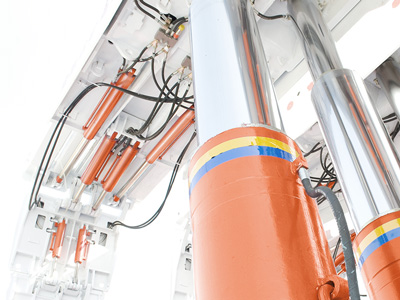Reduce decompression shock
& your cost of ownership
The challenges

In a cylinder circuit using space-saving cartridge logic elements to emulate a four-way directional valve function, minimizing decompression shock when changing from extend to retract can be a challenge. The larger the volume of oil being compressed (i.e., the larger the cylinder bore and/or stroke), the larger the shock potential from the stored hydraulic energy.
Not only is it disconcerting to witness a large piece of equipment react as pressure is relieved uncontrollably, but the shocks to the system also drive up cost of ownership, reducing cylinder life, destroying seals, increasing downtime and subjecting expensive machinery, operators and passengers to unnecessarily rough treatment.
Stored energy in the cap end of a cylinder is inevitable. Additionally, the machine frame and product being compressed can substantially increase the total stored energy. The goal in this situation is to release this energy in a controlled and consistent manner in the shortest time possible using an acceptable decompression rate for the system.
The problems
Some solutions introduce their own problems.
Dedicated decompression circuit components — staged-pilot-ratio check valves, orifices, solenoid valves controlled using electrical time-delay logic — can be expensive, unreliable, and inconsistent while adding to cycle time. Not the direction you want for your design.
Unbalanced logic elements are commonly applied in this situation, with the logic element helping to control the release of energy from the system and reducing shock. The issue with using widely available unbalanced logic elements is that as pressure increases on the load-holding port, the pilot pressure required to operate the valve increases.
That means to effectively use unbalanced logic elements, you need to be able to predict accurately the pressure on these valves throughout the operational cycle. Knowing this, you can then calculate the needed pilot pressure to make sure there is always enough pressure to actuate the logic valves. But the problem is that these calculations are difficult to nail down in a real-world system.
The solutions
A simpler solution, as described below, uses balanced logic elements which are unaffected by load-induced pressure on the working ports. You can use the same pilot pressure to operate the valve throughout the operating cycle. And there is a more consistent release of energy than with an unbalanced valve, resulting in a well-behaved machine.
See the example circuit below (Fig 1).
By using Sun’s DK*R balanced logic elements with a 2-way DAAL-*CN pilot valve and PRDB pressure reducer/reliever, you get a zero-leak, reliable, cost-effective, cap-end-to-tank, normally closed logic element.
The cartridge can also include Sun's T-8A cavity in the cartridge itself — model DK*R-8 — to accommodate the pilot control function within the cartridge body, resulting in a single integrated part to further simplify the design and your life. Read more about Sun's T-8A cavity concept.
Since this product is balanced, operating pressures on the work ports do not affect the opening speed of the valve. A typical poppet-style logic element exposes more and more area as the poppet moves to the open position, with the attendant increase in opening force.
 So, by adjusting the pilot pressure via the reducer, you easily can set an acceptable and repeatable opening time. This solution minimizes decompression shock in the shortest time with consistent results. If you use the newer soft-shift, 2-way DAAL-SCN as the pilot valve, you can further enhance tuning for shock reduction.
So, by adjusting the pilot pressure via the reducer, you easily can set an acceptable and repeatable opening time. This solution minimizes decompression shock in the shortest time with consistent results. If you use the newer soft-shift, 2-way DAAL-SCN as the pilot valve, you can further enhance tuning for shock reduction.
For a more detailed consideration of this circuit, refer to page 6 of our Logic Element Cartridges Technical Tip.
NOTE: Using Series 4 size cartridges, you can get flows up to 80 gpm (320 L/min) with a nominal 100 psi (7 bar) pressure drop. If larger flows are required, you can successfully apply two, three, and four DKJR logic elements in parallel and accommodate flows up to 320 gpm (1280 L/min). Of course, with multiple elements, it would require an external pilot valve sized for the number of cartridges involved instead of integral solenoid pilots in each element. Also, keep in mind that a balanced logic element can be used as a standalone valve in a machine with a common spool valve circuit if that machine is experiencing excessive decompression shock.
To discuss this solution with a local expert, contact your Sun distributor.
Download a PDF of this article.

